When I think of design thinking methodologies, I think of the design team at my first job. All Stanford d.school grads, these women wowed me with their approach to problem-solving. They encouraged me to think big, challenge assumptions, and take risks. Over a decade later, I still feel their influence.
So, for this article, I drew upon their inspiration and did two things I wouldn’t normally do: I reached out to someone from that design team (whom I haven’t spoken to in 11 years!), and I contacted Stanford University to try to snag an interview.
Would my former coworker remember me? Would Stanford reply? And could I, as a writer, even benefit from design thinking? Read on to find out, plus get tactical advice on how to apply design thinking methodologies to your work.
Table of Contents
- What is design thinking?
- What are the 5 methods or stages of design thinking?
- How Design Thinking Has Evolved at Stanford: The 8 Design Abilities
- How I Applied Design Thinking Methods to Write This Article
- Design Thinking Methodologies Recommended by UX Designers
- Design thinking methodologies are for everyone.
What is design thinking?
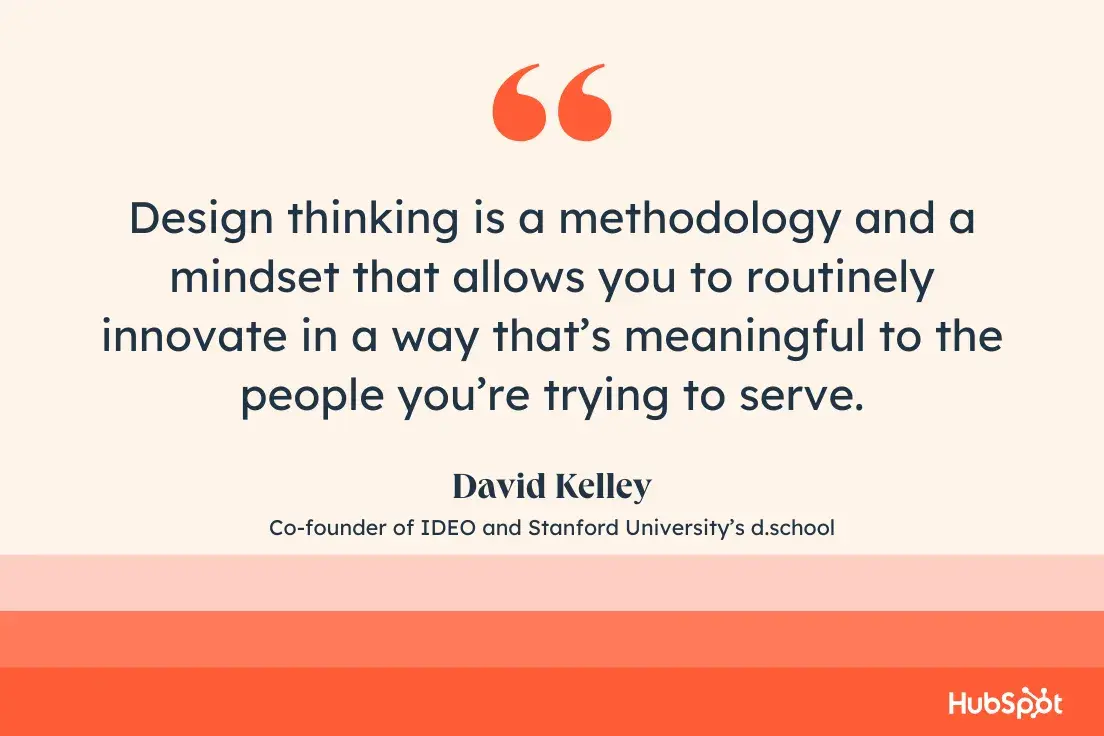
In my own words, I’d say design thinking is a way of problem-solving that fosters creativity and daring, new ideas in service of the end-user. It differs from conventional thinking, which might produce bold ideas for the sake of novelty or stick with tried-and-true methods that prioritize profit or pleasing the leadership team.
I like how design thinking challenges conventions and emphasizes empathy. We need more of that in this world.
Of course, I can’t talk about design thinking without mentioning Stanford University and , co-founder of IDEO and Stanford’s Hasso Plattner Institute of Design (also known as the d.school). He’s played a huge role in design thinking and is often .
I emailed Kelley for this article, and he graciously forwarded my message to someone (thanks, Deb!) who connected me with , the creative director of the .
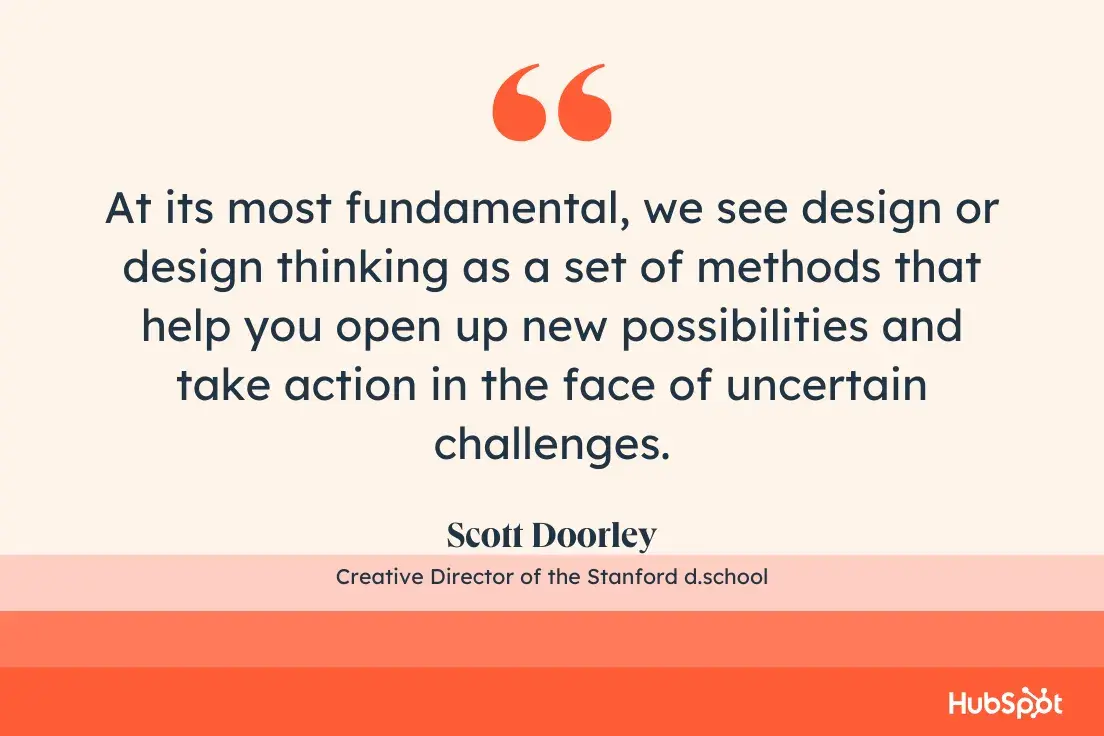
“At its most fundamental, we see design or design thinking as a set of methods that help you open up new possibilities and take action in the face of uncertain challenges,” says Doorley.
That’s something anyone can relate to — regardless of what field you’re in. In fact, that’s what I love so much about design thinking: It’s not just for designers.
In an , David Kelley himself said, “I'm very excited about design thinking as a mindset and a methodology, but it leads to something I think is even more important, and that is creative confidence, that people who have opted out of thinking of themselves as a creative person end up through having a bunch of successes with this methodology … you end up with this thing that you feel like a creative person.”
And so, through this article, I want to help you rediscover that you are, indeed, a creative person, no matter your job role.
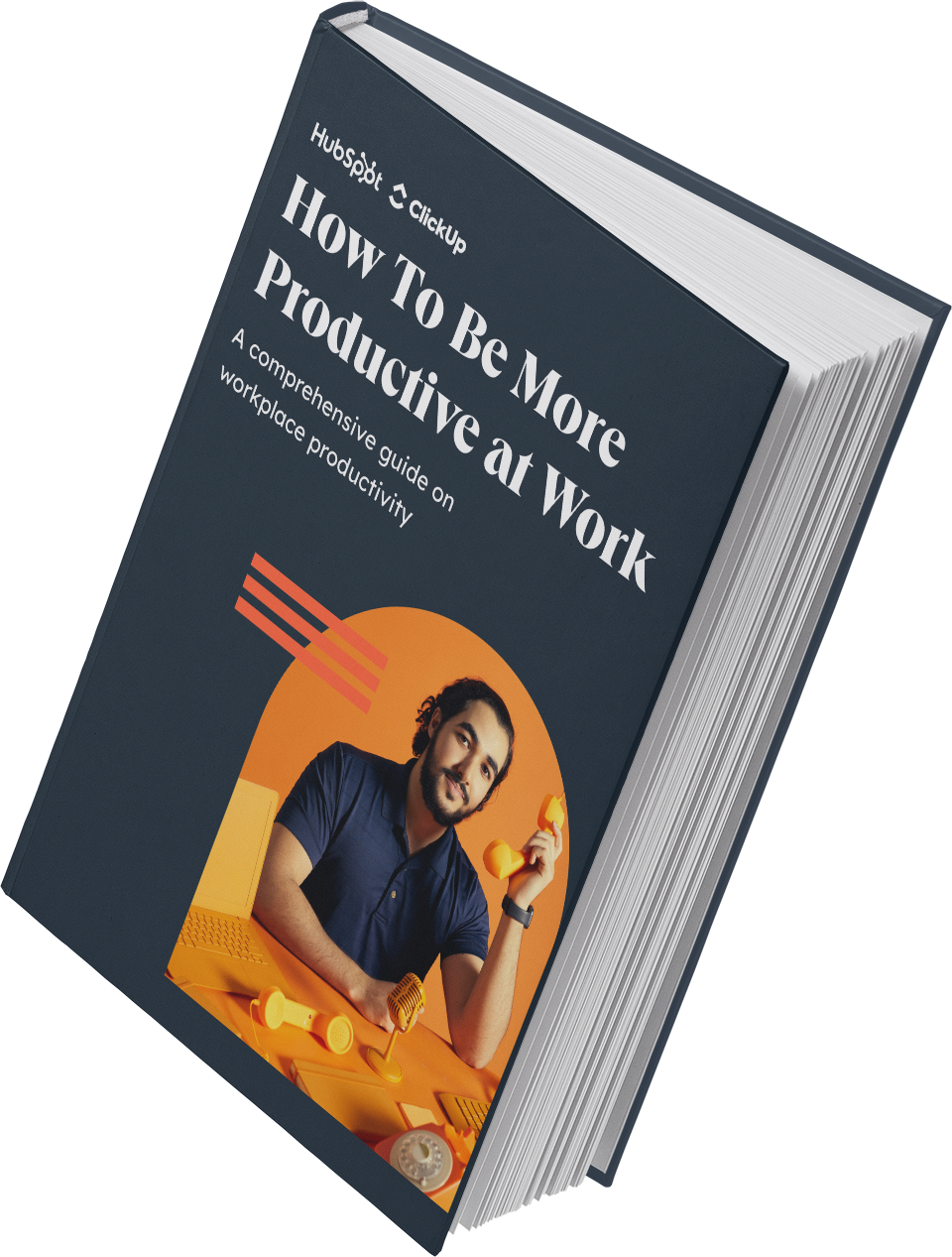
Free Workplace Productivity Guide
Stop procrastinating! Boost your productivity with this free kit.
- Free Productivity Guide
- PIE Scoring Template
- Labor Hours Calculator
- And more!
Download Free
All fields are required.

You're all set!
Click this link to access this resource at any time.
What are the 5 methods or stages of design thinking?
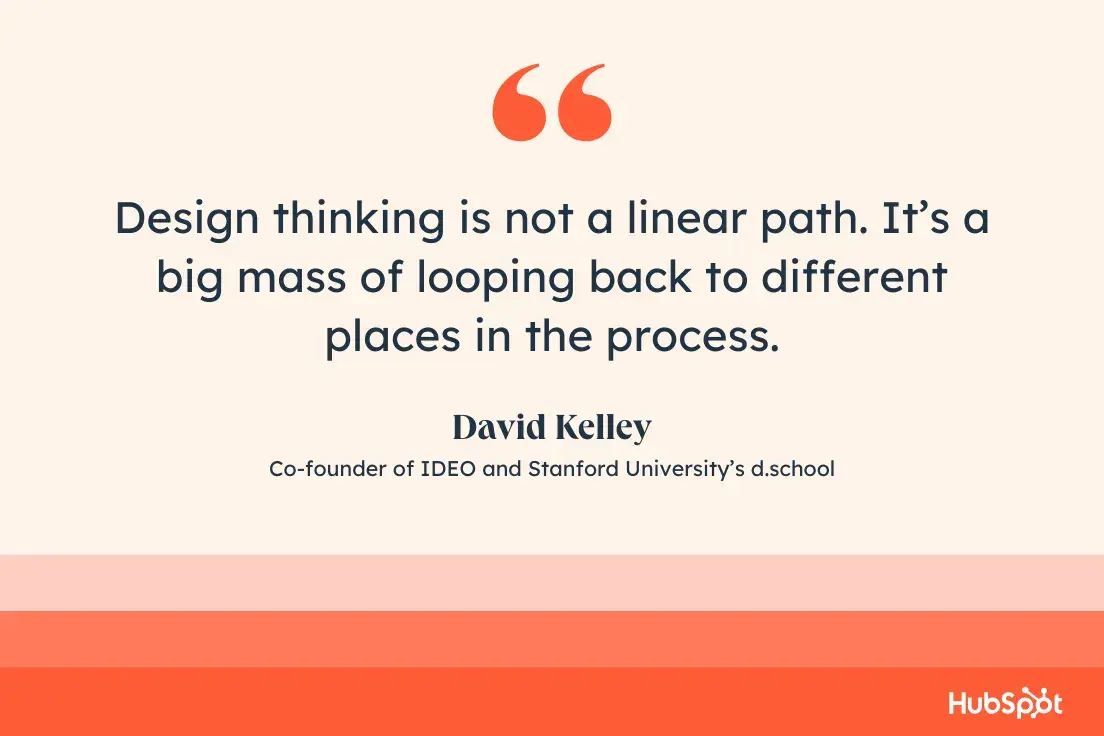
The five methods of design thinking are more aptly called the five “stages” or “phases.” Let’s briefly touch on those five phases before I jump into the exact tactical methods you can use to apply design thinking.
Here’s the most important thing, though: The design thinking stages are not linear.
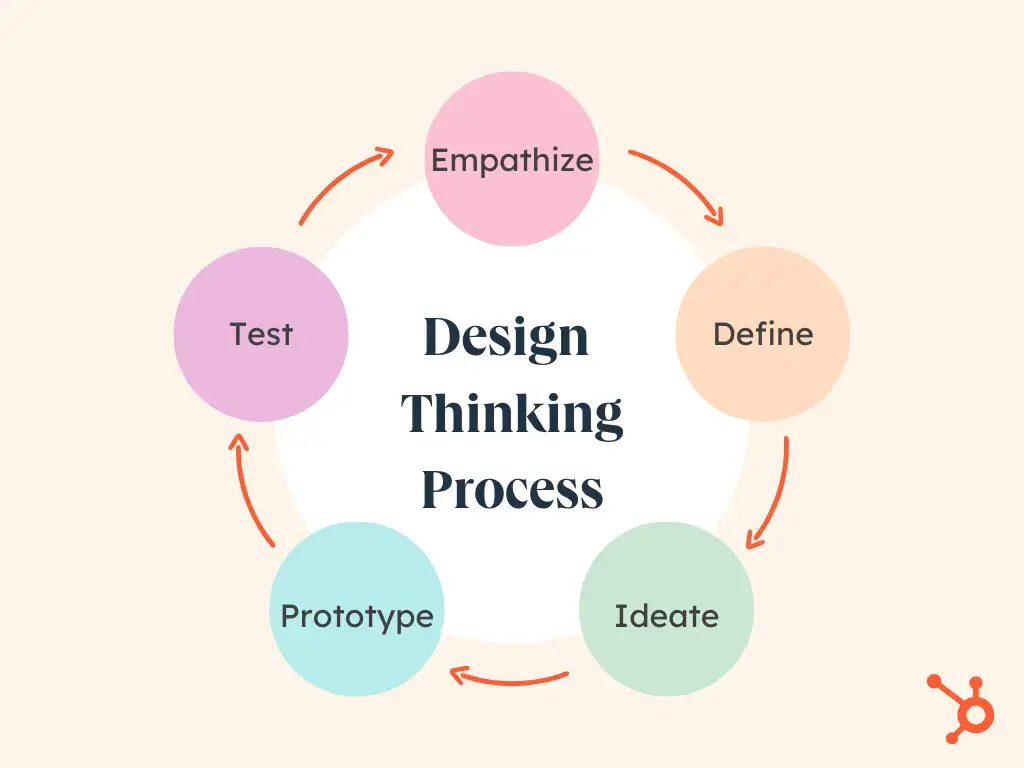
That means there’s no particular order you have to follow, and they can happen at any point in time as well as simultaneously. For instance, there isn’t a point at which you stop empathizing with the user. It carries throughout the process.
1. Empathize
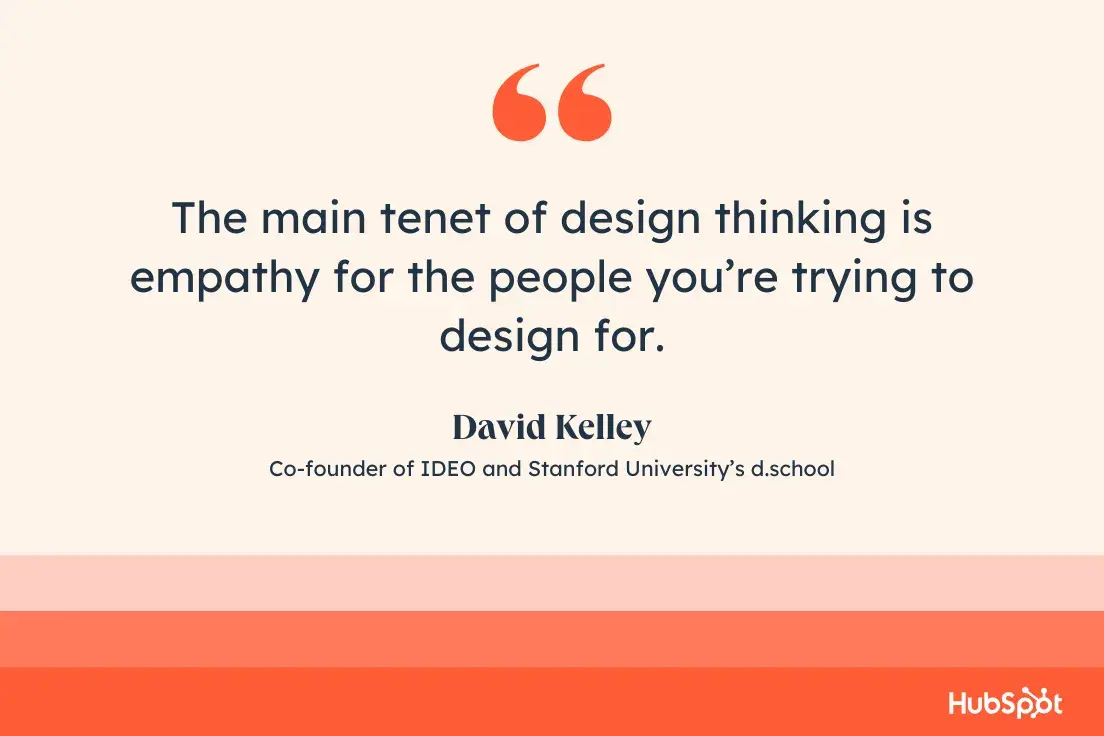
Good design isn’t about making things look good; it’s about making things that best serve the users you’re designing for. That’s why the first phase of design thinking is empathize.
Gain an understanding of what your users value, what problems they have, and what their hopes are for solutions. You can achieve this by interviewing potential users or conducting user testing.
2. Define
In phase two of the design thinking process, you define the problem. Use the information you’ve gathered from user research to write a clear problem statement.
I like the problem statement template recommended by former 探花精选ter Madison Zoey Vettorino:
"[INSERT PERSONA HERE] is facing [INSERT CHALLENGE HERE] when [INSERT CONTEXT IN WHICH CHALLENGE OCCURS], which is impacting their ability to [IMPACT OF THE CHALLENGE]."
Here’s the problem statement I came up with for this article: "Designers and marketers are facing difficulties finding tactical, useful advice when searching for information on design thinking, which is impacting their ability to serve their users through innovative, human-centric solutions.”
3. Ideate
Ideating, also known as brainstorming, involves coming up with potential solutions to the problem statement you created in the “define” phase.
4. Prototype
Now, the designing begins! In the prototype phase, you create a rough outline or basic model of what your solution will be. Don’t invest too much time into building your prototype, as it is not intended to be the complete product.
Instead, the prototype will be used in the next phase, “test.”
5. Test
Once you have your prototype(s) ready, it’s time for testing. In this phase of the design thinking process, you’ll test your prototypes with users to see if it meets their needs.
During testing, it’s perfectly acceptable and even expected to discover that your hypotheses were wrong.
That’s why the design thinking process is non-linear and iterative. You might decide to go back and build another prototype while, at the same time, you should continue to empathize with your users.
How Design Thinking Has Evolved at Stanford: The 8 Design Abilities
While many are familiar with the five phases or stages of design thinking, I was surprised to learn about the , which the Stanford d.school is emphasizing more recently in its pedagogy to empower its students.
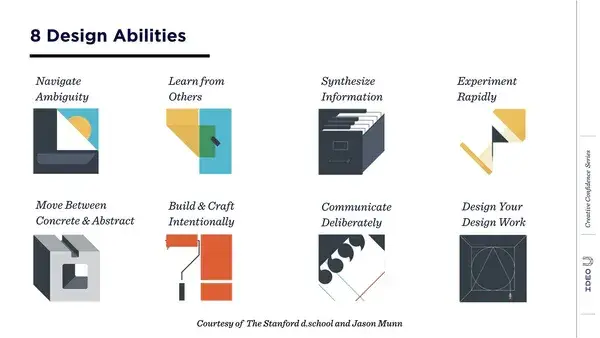
“As the world becomes more interconnected and technology comes on more quickly, the challenges of today—from education to online business to healthcare—call for more collaboration, experimentation, and perspective shifting than ever before,” explains Doorley.
“We design our curriculum to be iterative so we can respond to those needs. These days, ethics is taught earlier and is more integrated into our curriculum; our students choose methods area (like physical design and manufacturing or AI and digital user experience) as well as interdisciplinary domains (like designing for health or designing for social impact).
“Our classes have also moved into more surprising areas (like Wild Ways of Making—from AI to synthetic biology—and Forbidden Design—where students take on emerging possibilities).”
And if you’re curious, yes, the d.school applies design thinking methods to its own projects, including a website redesign that will be released later this year.
“We have been working with a fantastic design studio called Firebelly who takes a human-centered design approach to digital product design,” says Doorley. “It's a case of collaborating with a partner who helps us turn design methods on ourselves.
“During discovery, Firebelly used several design tools to gain insights, from user surveys to 1:1 and small group interviews to interactive workshops with diverse stakeholders. The process oscillated between divergent visual experimentation and convergent strategic research."
, managing director at , adds, “Through several rounds of design revisions, we stress-tested aesthetic boundaries and established a distinct visual language—one that balanced the d.school’s appetite for risk, dynamism, and verve with the long-standing tradition of a university. Ensuring our design and strategy pathways converged, we engaged real end-users to test and validate the wireframes for key components and pages on the site.”

Free Workplace Productivity Guide
Stop procrastinating! Boost your productivity with this free kit.
- Free Productivity Guide
- PIE Scoring Template
- Labor Hours Calculator
- And more!
Download Free
All fields are required.

You're all set!
Click this link to access this resource at any time.
How I Applied Design Thinking Methods to Write This Article
Before writing this article, I already knew how I wanted to structure it based on how I typically approach blog posts: It would be a listicle of design thinking methods categorized by which phase of the design thinking process they fit into (Empathize, Define, Ideate, Prototype, or Test).
Why? Well, because that’s what my competitors did.
But then I heard back from , my coworker from 11 years ago. She’s now applying her design thinking skills as the head of user research at , a climate tech company digitizing the carbon market.
We chatted about life and design thinking, and when I told her how I was structuring this article, she, in true Stanford designer fashion, challenged me.
“Does it have to be like that?” Heitz asked. I squirmed in my chair. I knew she had a point.
Later, she added, “I challenge you to apply the design thinking to your article."
She encouraged me to ask myself, "What are the different ways I can write this?" beyond the listicle format.
"Even if they're bad ideas, even just writing them down will help you think of other ways," she said.
Aurelia — challenge accepted! For this article, I forced myself to think outside of the box to better serve my readers. I did that by using four of the design thinking methods I learned during research. And below, I’ll share my results.
Design Thinking Methodologies Recommended by UX Designers
1. Crazy Eights
Best for:
Finding new ways of doing things
Steps:
Step 1: Take a large sheet of paper and fold it in half three times so you end up with eight squares.
Step 2: Spend 60 seconds sketching or writing an idea or solution in each square.
Step 3: If you're doing this as a group, share your ideas with each other.
Crazy Eights is a design thinking method that brought me out of the digital realm and into the physical world — which, as a blogger and chronically online person, I desperately needed. Research has long upheld the .
“This one helps people think about it on their own first,” explains Heitz. “And being able to have a voice, even if they're not necessarily more of the vocal people. And then you have a piece of paper, a physical artifact with all of the different ideas. So whoever is actually doing the design work after that can take those artifacts and build on top of it.”
I had to dig out a long-forgotten sketch pad in the back of my bedroom closet to get a sheet of paper.

Then, I folded it three times to create eight squares.

It has been so long since I’ve handwritten anything that my hand cramped up. I was surprised by how quickly 60 seconds flew by.
“You can take more time if you need,” says Heitz, “but usually the idea is that you just want something that's super fast, and you want to think of a lot. And so it can be hard for some people.”
By the time I got to square five, I was convinced there was no way to come up with more ideas, but I managed to fill all eight squares with no breaks in between.

This exercise helped me realize that there were so many other headlines and ways of structuring this blog post. I ended up modifying my original outline by adding some of the ideas I came up with while doing Crazy Eights.
2. 5 Whys
Best for:
Pinpointing the root cause of a problem, gaining empathy for your users
Steps:
Step 1: Write a problem statement.
Step 2: Ask “Why?” until you reach the root cause.
Step 3: Write a corrective action based on the last why.
The 5 Whys design thinking method helps you pinpoint the root cause of a problem, which is essential in helping you empathize with your users.
“I always think about [the 5 Whys] and always try to apply it,” says Heitz. “It's essentially taking a scenario, and the goal is to try to understand the motivations, the desires, and why something is happening or why someone is doing something.”
She adds, “You're essentially breaking out the problem and able to brainstorm based on those different factors.”
Pro tip: 探花精选 created this , which was super convenient for me to try this exercise.
So, I began by asking, “Why am I writing this article?” Like, what problem does it solve? Well, professionals struggle to find information online on how to apply design thinking to their work. I want to write an informative piece that helps them.

During my preliminary research for this article, I started by Googling “design thinking methodologies” to see which articles ranked on the first page.
When I examined these further, I realized the top four search results had these characteristics in common:
- They outlined design thinking as four to five stages.
- They categorized tools and methods into those four to five stages.
- They lacked expert quotes.
- They lacked tactical advice on how the reader could apply principles to their work.
- They lacked a first-person perspective.
Based on this, I could complete the 5 Whys template, though I only had to ask why four times to get to my root cause.
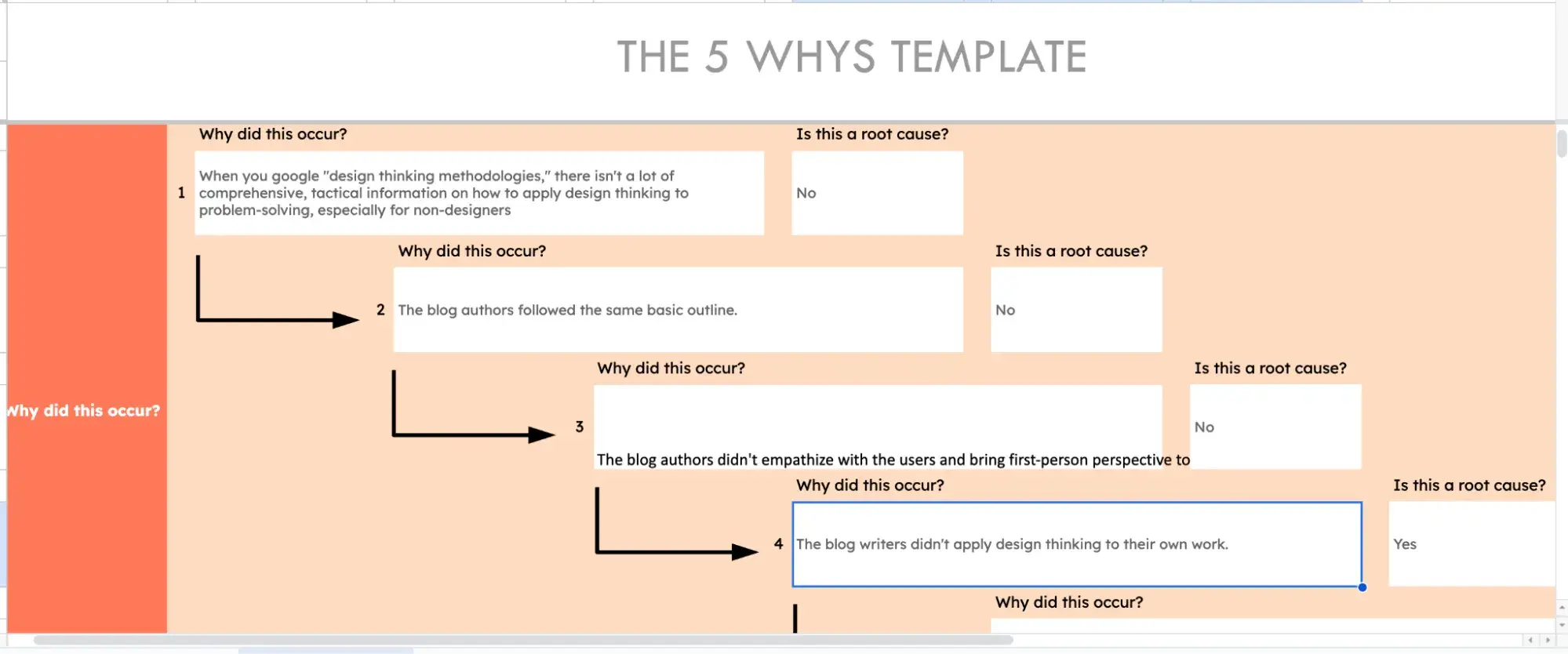

To help me think outside the box, I asked ChatGPT to review my 5 Whys template and tell me how to improve it.
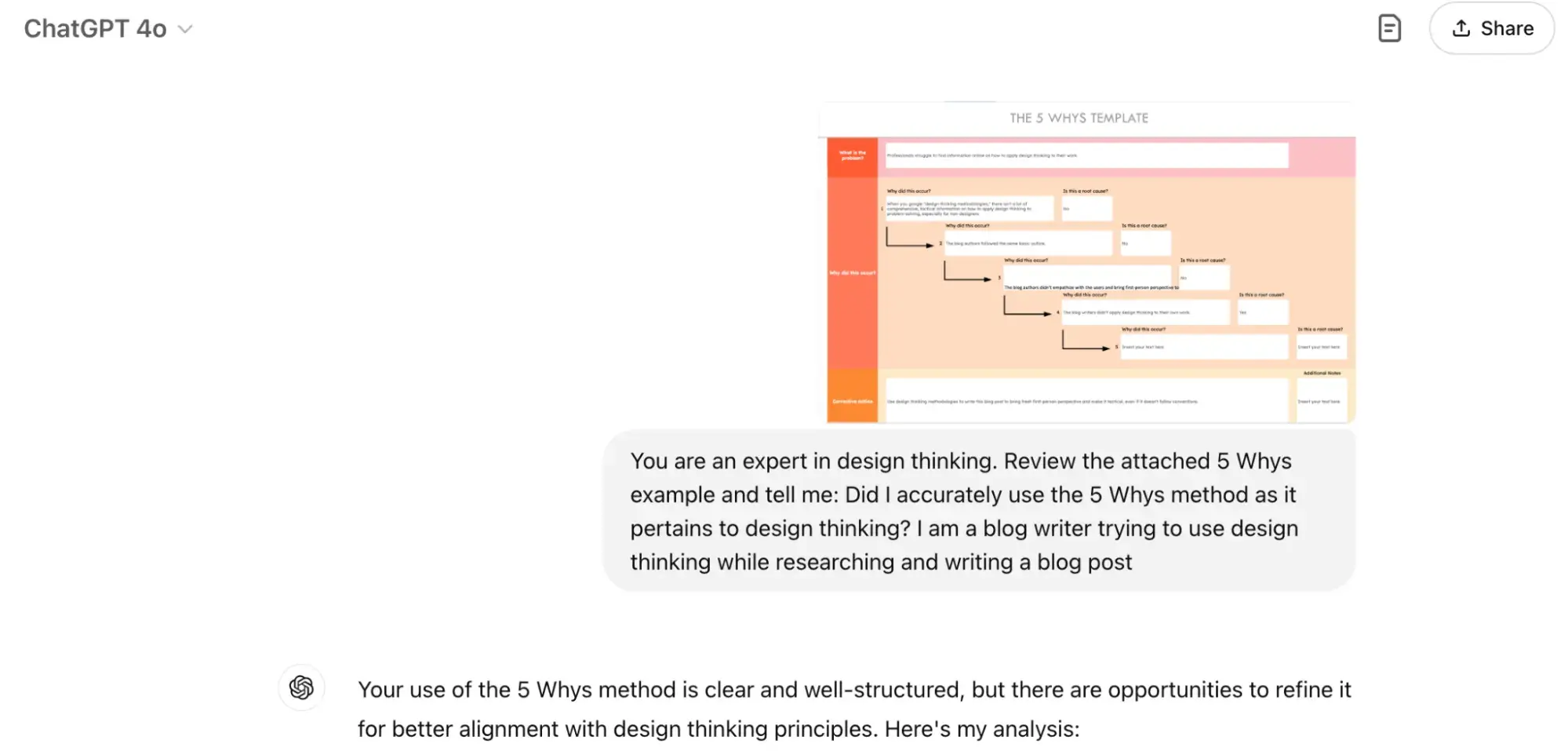

Here’s the newly reworded template based on ChatGPT’s outputs, which encouraged me to further empathize with my users:
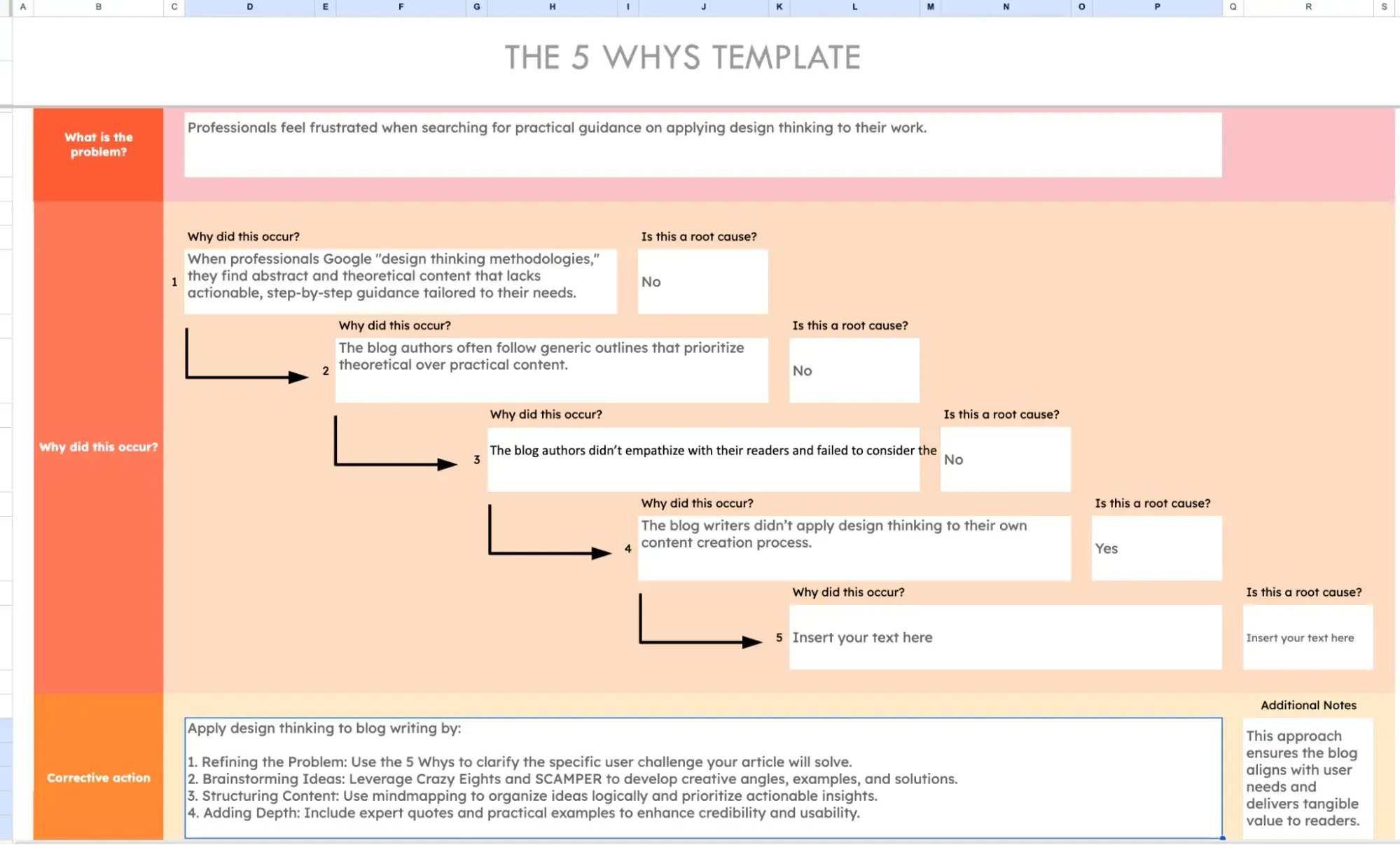
Pro tip: Know when to stop. Stop asking why when you get to the root cause that applies to your role and situation. You don’t have to ask why exactly five times.
For example, I could’ve kept asking why and get to the root cause of, “Employees aren’t trained to use design thinking,” but I don’t work in HR. I am a blog writer, so I stopped at the point that made the most sense for me.

Free Workplace Productivity Guide
Stop procrastinating! Boost your productivity with this free kit.
- Free Productivity Guide
- PIE Scoring Template
- Labor Hours Calculator
- And more!
Download Free
All fields are required.

You're all set!
Click this link to access this resource at any time.
3. Journey Mapping
Best for:
Understanding how your users think, feel, and act
Steps:
Step 1: Gather information about your users.
Step 2: Use . For each customer journey stage, ask, “What is the customer thinking or feeling?”
Step 3: What is the customer’s action?
Step 4: What or where is the buyer researching?
Step 5: How will we move the buyer along his or her journey with us in mind?
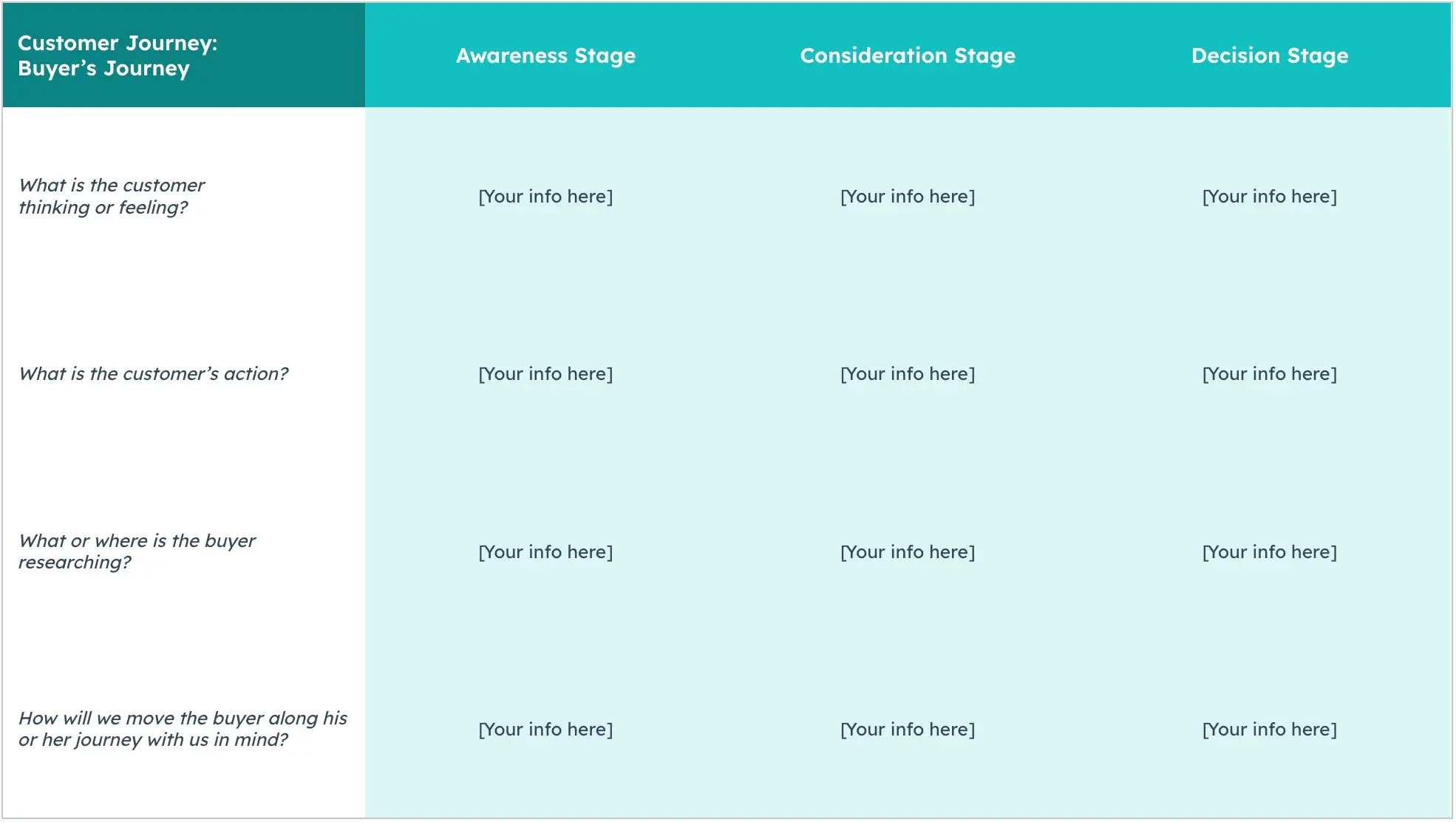
Journey mapping is an opportunity to put yourself in your users’ shoes by considering what they’re thinking, feeling, doing, and researching at every step of the journey.
Heitz recommends conducting journey mapping on two levels:
- The journey someone takes through your product
- The journey someone takes outside of your product in their real life
“And those can help in two different ways,” she explains. “The second one I mentioned is more abstract, and it kind of helps you understand their context and how they would integrate your product and what they need.
“Oftentimes, that helps you think of features that you didn't even think of that they would need. For example, they would need, like, a download button of all of the information that’s on your site because what they're doing is actually something afterwards that’s external.
“And then there's the journey mapping of your product within your product, which usually starts with like, ‘And then they signed in, and then they went to this page,’ and that’s also really useful.”
Journey mapping gives you more context on what the user is actually doing with your product, says Heitz, helping you devise ways to improve user flow.
4. SCAMPER Method
Best for:
Finding new applications for old products or processes
Steps:
The SCAMPER Method stands for:
- Substitute: What can you swap out from the existing design, product, or service?
- Combine: What processes, products, or tactics can you combine?
- Adapt: How can you adapt something you already have to solve your problem?
- Modify: What can you take from the existing design or product and modify?
- Put to other use: What alternative uses can you come up with for your product or service?
- Eliminate: What can you eliminate in your current product or design?
- Rearrange: How can you rearrange existing parts to create something new?
“I like using SCAMPER as a jumping-off point because it helps get the creativity flowing and challenges you to think outside your normal mental flow,” says , founder of . “It's often hard to figure out how your website should look because there are plenty of great options, but it’s much easier to pick a few great websites and use SCAMPER to turn them into something new.
“If you like certain elements of a website, you can take them, break them, substitute parts, combine features, and eliminate anything you don't like or need to create something fresh.”
SCAMPER is a fantastic design thinking tool for innovating upon existing products or services. That made it a great tool for me to use when writing this article.
I took existing outlines of the top-ranking design thinking methodologies articles out there and found ways to remix them to create something new and user-centric. For this, I used a .
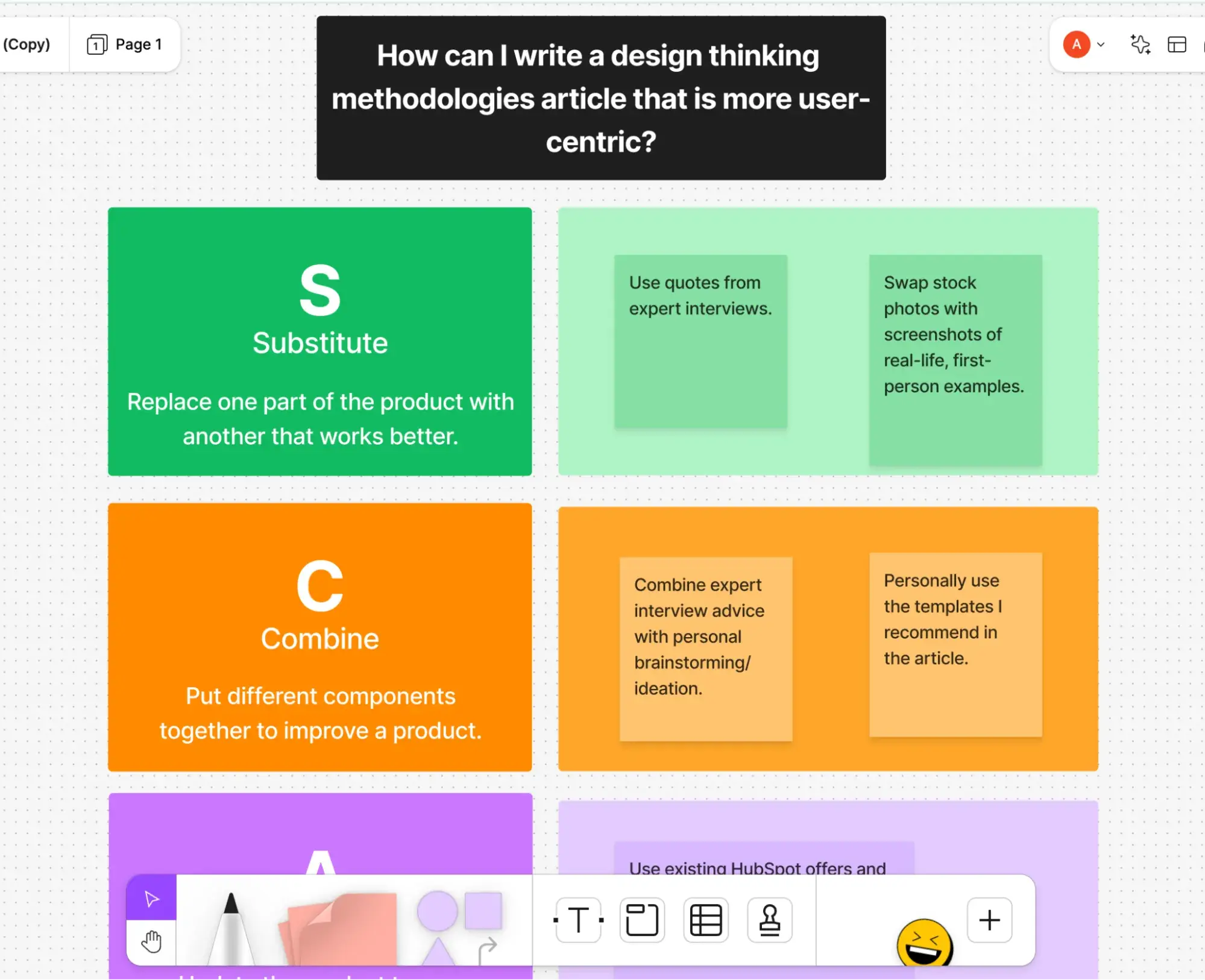
SCAMPER was probably my favorite design thinking method on this list. Instead of reinventing the proverbial wheel, this method teaches you how to rethink how you use it. For example, while every existing post I read listed the design thinking phases in the same order, what if I changed the order?
Better yet, what if I didn’t put the phases in a list at all? Because of the nature of writing, that was impossible, but it did give me the idea for the circular diagram I created to help emphasize design thinking’s non-linear nature.
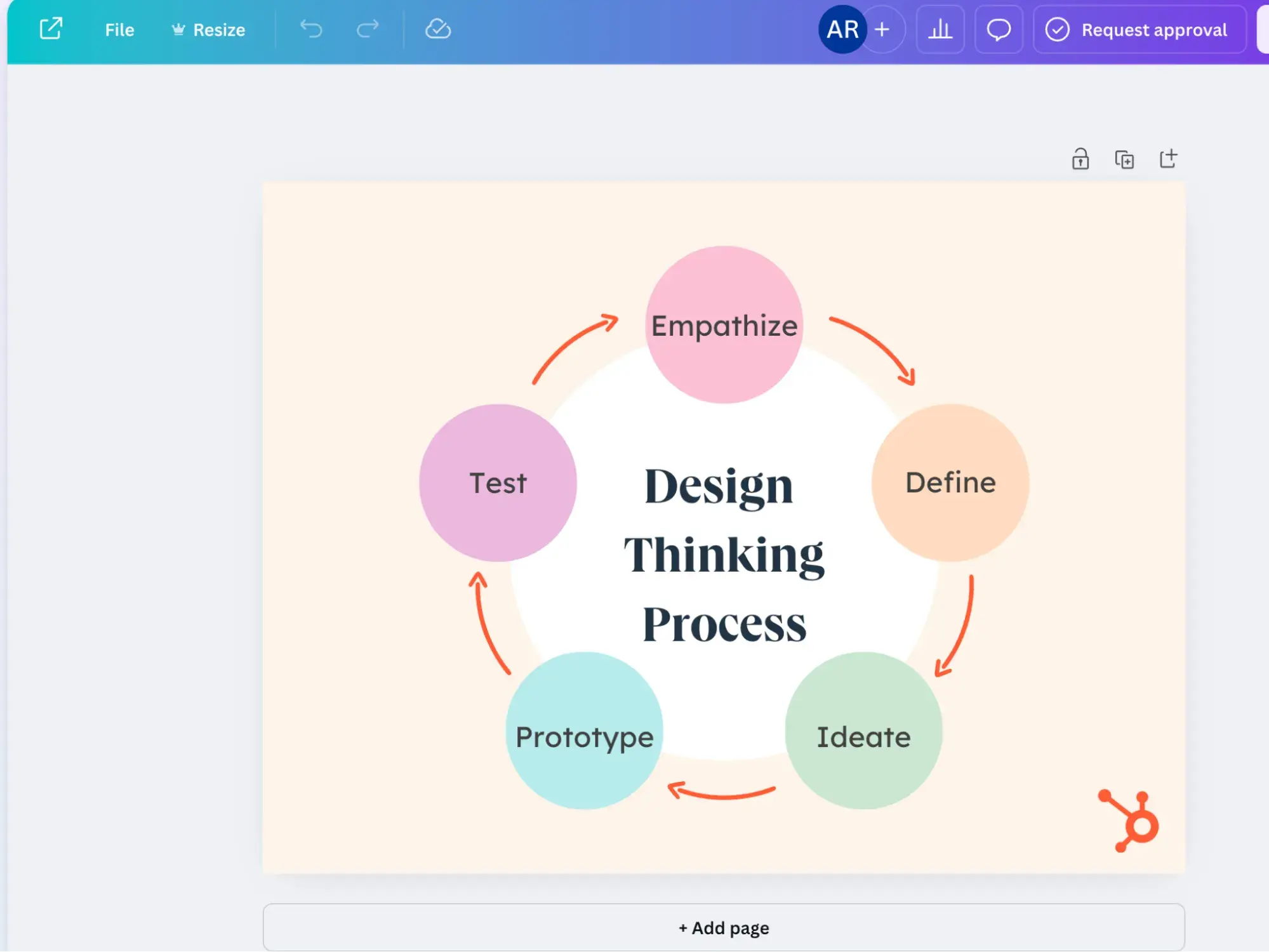
Pro tip: Just because you generate new ideas with a design thinking method like SCAMPER doesn’t mean you must use any of those ideas in the final product. For example, I wrote “Eliminate ‘What is design thinking?’” but ended up not implementing it.
5. Lightning Demos (Related Worlds)
Best for:
Gaining inspiration from existing products, generating new ideas, and creating a lightweight “prototype” before building the full product
Steps:
Step 1: Make a list of problems you’re trying to solve and/or features that you want your product to have.
Step 2: Find inspiring real-life examples that do those things well.
Step 3: Make a list of your examples with screenshots (aim for at least three examples each).
Step 4: Present your demo to the team. Assign a facilitator to write down ideas.
, founder of , recommends , which he uses to generate ideas.
“I facilitate a workshop with the team to look at great solutions from a range of companies and industries,” Nguyen explains. “The goal is using existing ideas to remix and improve. We're searching for existing ideas we can use to inform your solution.”
I love looking for inspiration in real-life examples, so this method really resonated with me.
Nguyen adds, “It's like playing with Lego bricks: first gather useful components, then convert them into something original and new.”

Free Workplace Productivity Guide
Stop procrastinating! Boost your productivity with this free kit.
- Free Productivity Guide
- PIE Scoring Template
- Labor Hours Calculator
- And more!
Download Free
All fields are required.

You're all set!
Click this link to access this resource at any time.
6. Mind Mapping
Best for:
Visualizing abstract ideas, finding connections between concepts, adding structure to ideas
Steps:
Step 1: Fill out .
Step 2: Think through how concepts might be related to each other. Feel free to do multiple mind maps for the same topic. It’ll help you see the topic in new ways.
Mind mapping is a design thinking tool that helps you visualize concepts and see how they are related. It’s useful for applying structure to otherwise unorganized thoughts.
Pro tip: 探花精选 has a free you can use to get started.
“Mind mapping is helpful because it helps me break down a relatively large topic, like a content strategy, and branch out into smaller chunks of related topics,” says , head of organic growth at . “It helps you build some structure of unstructured thought and uncover connections you might not otherwise see.
“In site structure, for example, getting everything down in a mind map can help you build an architecture that makes sense and connects the right dots to each other. Without that visualization, it's too easy to miss things, which can mess with flow and user experience.”
As a writer who for the past 12+ years has organized my thoughts in a written outline, I found mind mapping really disorienting.
I used . I tried two different kinds of mind maps to organize my thoughts and try to come up with new ideas. But it didn’t really work for me.
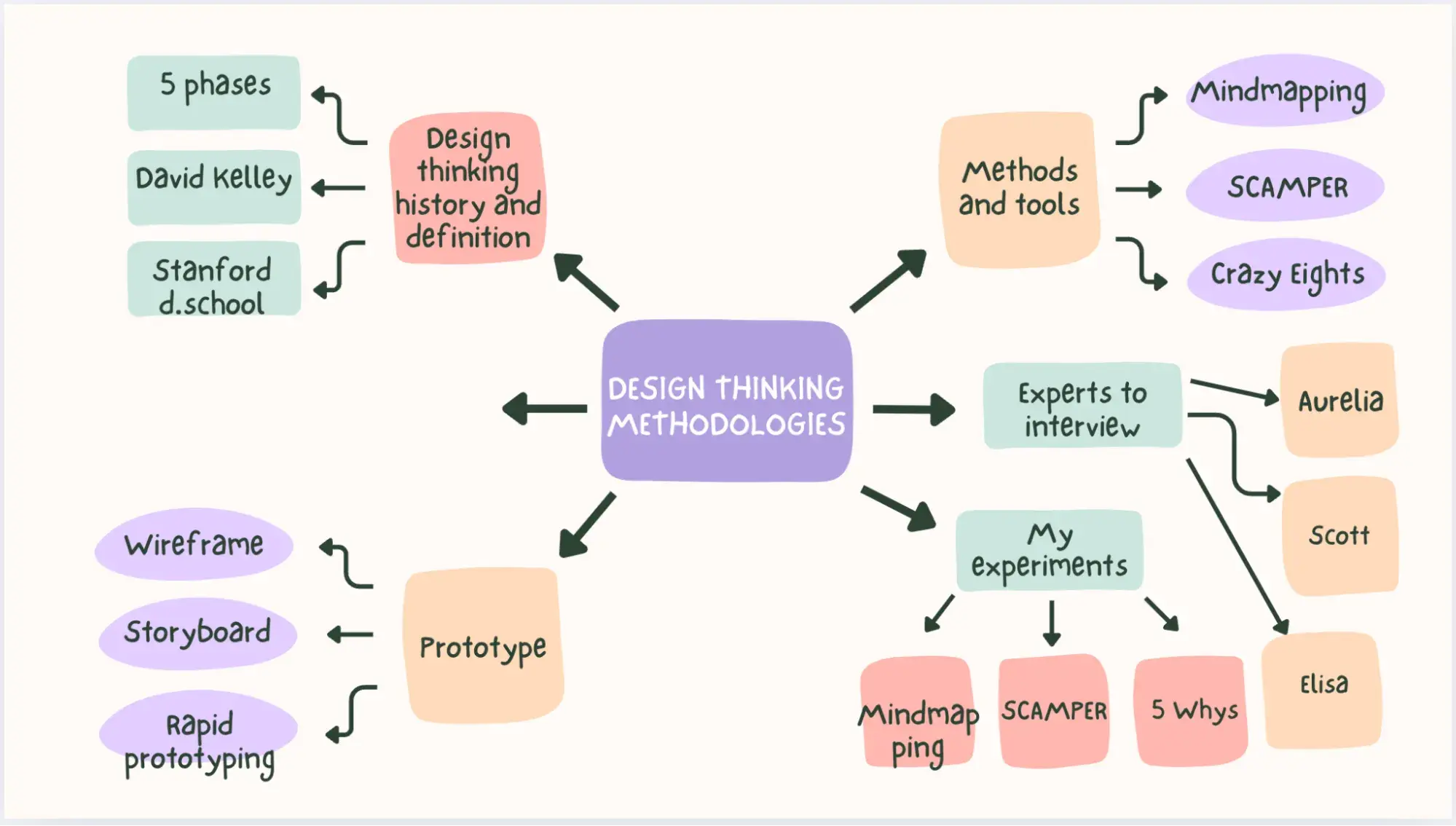
At first, I couldn’t get the hang of the mind map because I was trying so hard to translate my written article outline into a visual map — placing headings and subheadings into it.
But then, I had a breakthrough: What if I thought of the map as the architecture of a website? That way, each bubble could represent a webpage. For some reason, that helped me. It helped me realize which categories were actually subcategories that I could fit under one heading instead of making another heading altogether.
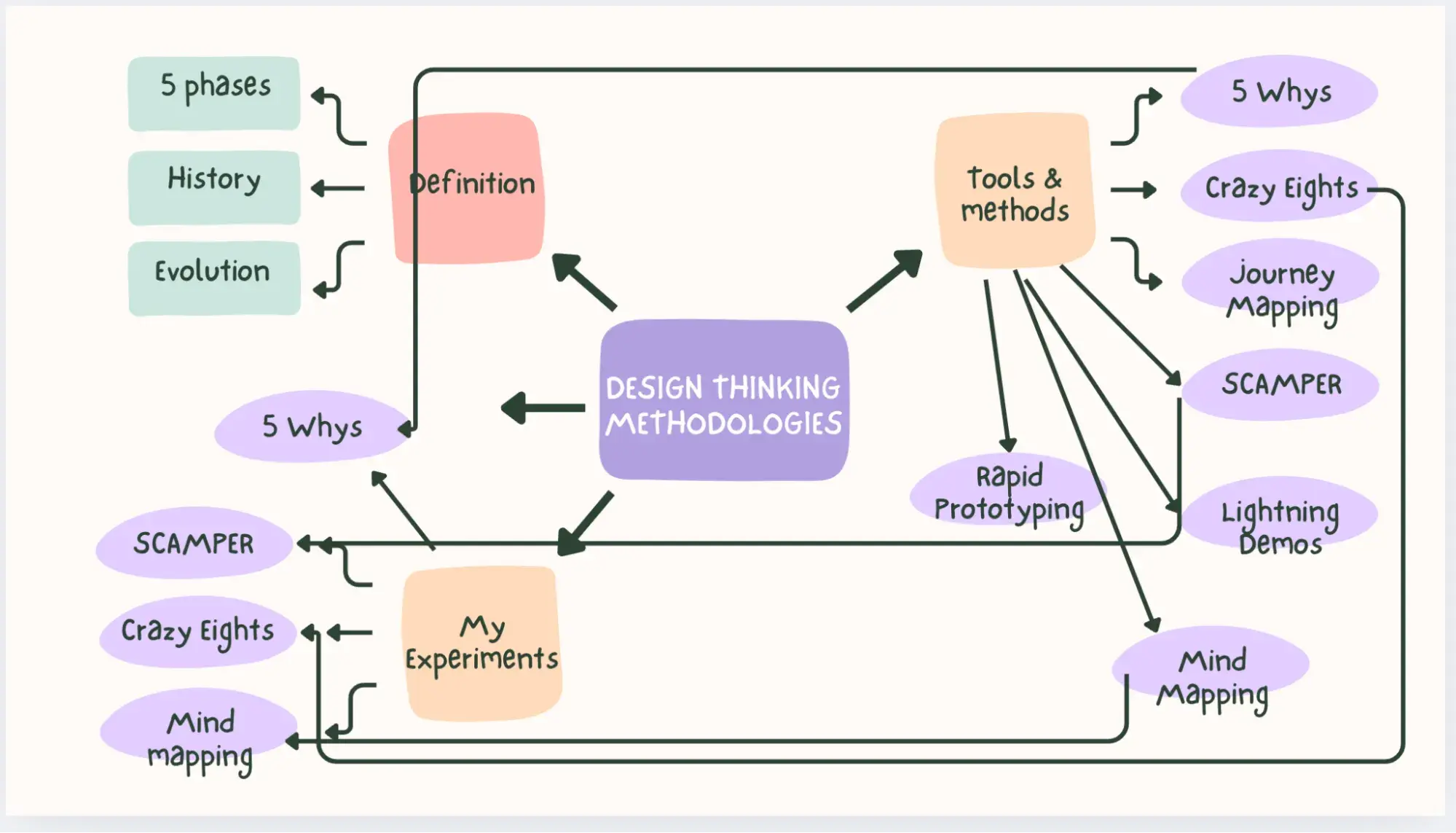
7. Rapid Prototyping
Best for:
Quickly gaining feedback on ideas before investing more time, energy, and resources into them
Steps:
For this, you simply need to figure out the most scaled-back version of your product that can get you feedback before going all in on the full product. You can also think of this as your Minimum Viable Product (MVP).
As a freelance writer, my rapid prototyping involves writing outlines for the client to approve before I write the full article.
This allows me to spend less than an hour laying out the basic bullet points of the article’s structure, along with brief descriptions of what each section will say, without investing too much time into writing the full draft.
Imagine if I wrote an entire 2,000-word article only to find that it wasn’t what my client envisioned.
By creating low-fidelity prototypes via outlines, I’m able to gather feedback before I begin work on the real thing.
As , CEO of , explains, “Rapid prototyping involves creating quick, low-fidelity versions of a design so you can test concepts and ideas early without spending too much time perfecting details that might change later.
“This method helps everyone involved, including designers, clients, and stakeholders, visualize how the final product might look and work before committing to a specific direction.”
For example, it’s common for UI designers to create low-fidelity wireframes of a website design for clients to review before the designers invest substantial time into high-fidelity mockups.
But again, this applies outside of design, too. A writer might do an outline before creating the full article. A videographer might write a script or create a storyboard before filming a video. Or a marketer might create a slide deck of an email marketing campaign before building it out in the email marketing software.
Design thinking methodologies are for everyone.
If there’s one thing I could tell my 22-year-old self who was longing to be on my startup’s design team, it’s this: Design thinking is for everyone. I didn’t need to get a degree from Stanford or even be a designer to start thinking like one.
What I love about design thinking methodologies is that they apply to any area of life that calls for creativity. As I showed in this post, I benefited from designers' tools even as a writer.
Thanks to design thinking methods, this article turned out far different from how I envisioned it at the beginning. Initially, I planned this article based on what other bloggers were doing.
Thanks to Heitz and design thinking, I pivoted to crafting this article based on what my readers would find most useful — which is how we on the 探花精选 Blog Team operate anyway.
Instead of trying to fit the design thinking methods into neat categories, I allowed them to flow and overlap the different phases, which is how they operate in the real world. Lightning Demos, for example, can be used to empathize, ideate, or even prototype.
Design thinking shows that the best ideas can’t be squeezed into a box — and neither should your creativity. So whether you’re a designer, marketer, writer, or accountant, experiment with design thinking methods in your work. I think you’ll be pleasantly surprised by the results.

Free Workplace Productivity Guide
Stop procrastinating! Boost your productivity with this free kit.
- Free Productivity Guide
- PIE Scoring Template
- Labor Hours Calculator
- And more!
Download Free
All fields are required.

You're all set!
Click this link to access this resource at any time.



![What's a Design System & What Components Is It Made Up of? [Examples]](https://53.fs1.hubspotusercontent-na1.net/hubfs/53/design-system.png)
.webp)


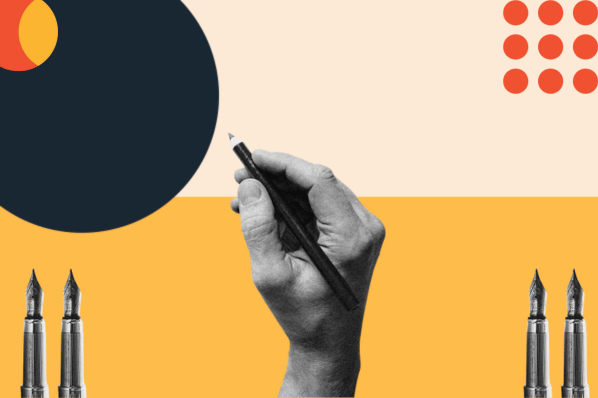
.jpeg)